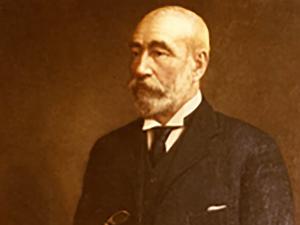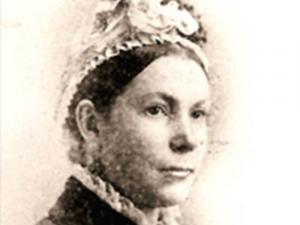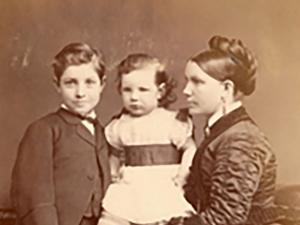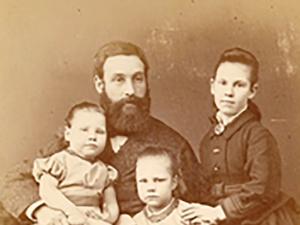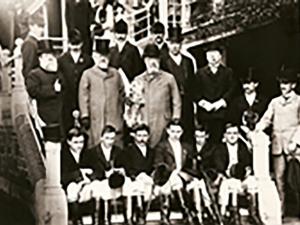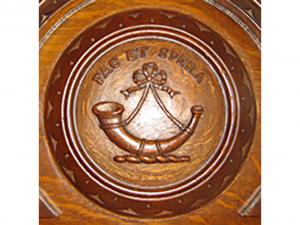Peter Waite
Peter Waite 1834 - 1922
Family background
Peter Waite was born in Kirkcaldy, Scotland in 1834, the third son of James and Elizabeth Waite.
His father died in the same year as a result of a fall from a horse leaving his mother to carry on the modest family farm, Pitcairn, and raise their children, James (5), David (3), and Peter (5 months). Peter undertook an apprenticeship in ironmongery, and worked in Edinburgh and Aberdeen.
In 1859 when he was 25 years old, Peter decided to join his brothers who had migrated to the Colony of South Australia. At the time he had been engaged for two years to his cousin Matilda Methuen and she agreed to wait until he was in a position to send for her.
It is likely the Waite brothers were influenced in their decision to migrate to South Australia by reports received through the family of merchant and shipowner, George Elder, also from Kirkcaldy. Elder’s sons had already established a successful family business in the new colony.
Arrival in South Australia
On arrival in Adelaide in 1859 Peter joined his brother James at ‘Pandappa’, a pastoral property near Terowie in the north east of South Australia. Peter quickly adapted to the harsh conditions and in 1862 Thomas Elder offered him the lease of a nearby property, ‘Paratoo’. When James Waite was drowned in 1863, while crossing a flooded creek on horseback, Peter took over both stations.
By 1864, Peter had established himself as a pastoralist and property manager, and the ‘Paratoo’ homestead had been made comfortable. He was now in a position to send for his fiancée, Matilda. She sailed for South Australia on the maiden voyage of the ‘City of Adelaide’ and their marriage took place at Robert Barr Smith’s home at Woodville in November 1864. Then followed a long journey for the newlyweds to ‘Paratoo’ in horse drawn vehicles.
The property manager – coping with low rainfall land management
Peter Waite was innovative in his improvement and management of the semi-arid salt bush country. He set up fenced paddocks, imported 265 tons of fencing wire and designed a metal dropper to support the fences. He sank wells and bores, and experimented with the use of steam traction engines for the excavation of earth tanks known as dams. His aim was for each paddock to have as permanent a supply of water as possible with the sheep being rotated between paddocks. Peter was a strong advocate of “spelling”, where pastures were periodically “spelled” or protected from grazing to allow for their regeneration. It was estimated that by 1874, only 15 years after his arrival in the colony, he was overseeing a large area carrying 260,000 sheep.
In the 1860s and 1870s Thomas Elder, N. E. Phillipson and Peter Waite acquired further leases to the east and north of ‘Paratoo’, an area which was largely undeveloped at that time. The Beltana Pastoral Company initiated in 1862 by Thomas Elder, with Peter Waite supervising from 1869, ultimately comprised many runs stretching from the Flinders Ranges to the South Australia-Queensland border. The lease of ‘Mutooroo’ was acquired in 1868. After Sir Thomas Elder died in 1897, Robert Barr Smith became Chairman of the Board of Directors of the Beltana Pastoral Co. Ltd. and of the Mutooroo Pastoral Co. Ltd. Waite became the Managing Director of these companies, frequently visiting their landholdings to check on operations.
Peter Waite was a member and Vice-president of the Pastoralists Association of South Australia and West Darling, and the Federated Employers’ Council of South Australia. In 1875 he became Chairman of the Stockbreeders’ Association.
Purchase of the Urrbrae property and involvement with agri-business in Adelaide
By 1874 Peter Waite was a Justice of the Peace and resident magistrate at ‘Paratoo’. His career continued to expand rapidly on all fronts - financial, commercial, domestic and social.
While visiting Adelaide in the early 1870s Peter expressed interest in a 54-hectare property at Urrbrae. Thomas Elder undertook to help Peter acquire the property in 1875 with the understanding that Elder might agist his racehorses there. In 1875 the Waite family moved from ‘Paratoo’ to a rented residence at Glenelg before finally moving into Urrbrae House in 1877 on their return from an overseas visit.
In the late 1880s a major reconstruction and enlargement of Urrbrae House was undertaken and when completed in 1891 it was one of Adelaide’s significant mansions. Peter took a great interest in the décor of the House employing Aldam Heaton from London to advise on the furnishings. Urrbrae House was the first home in Adelaide to have electrical light in 1891 and also a refrigeration system installed in 1895.
Peter Waite had an interest in the arts and made a collection of contemporary watercolours including some purchased in Rome as well as 31 paintings from Arthur Streeton. He was a member of the Adelaide Hunt Club and a hunting horn featured on the family crest. The motto on the crest, Fac et Spera, which loosely translates into ‘Do and Hope’, best represents his full and enthusiastic life.
Over the years Peter Waite became increasingly involved with the administration of Thomas Elder’s companies. In 1883 he became Chairman of Elders Wool and Produce Co. Ltd which controlled the auction side of the wool and produce business. When this merged with the parent company in 1888 it became Elder Smith & Co. Ltd. with Peter Waite as Chairman of Directors. Peter held this position for 33 years. He also had directorships in the Commercial Union Assurance Co. Ltd., the British Broken Hill Co. Ltd., and the SA Woollen Co. Ltd.
The eight children of Peter and Matilda Waite
Five children were born when Peter and Matilda were living at ‘Paratoo’ Station. The couple’s first child, Agnes, was born in 1866 in Burra. A son, James, was born in 1867 followed in 1869 by a second son, John who lived only for 12 days. Matilda then travelled to Glenelg for the births of Elizabeth in 1870 and Lily in 1873. After the family moved to Adelaide, David was born in 1875. A seventh child, Maud, was born in 1877 but lived only two months. The youngest daughter, Eva, was born in 1880. In 1879 Agnes died from complications following diphtheria.
Peter Waite’s eldest son, James, did not follow in his father’s pastoral footsteps but instead went to England in 1885 to train as an engineer where he subsequently developed a distinguished career. James married in England and had one daughter, Peter Waite’s only grandchild, Dorothy.
Peter Waite’s third son David worked in the pastoral businesses in which his father was involved, and was well known in both pastoral and social circles in South Australia. While travelling by ship to the United Kingdom via South Africa in May 1913 he disappeared overnight. This was a tragic event for the Waite family and especially for his 79 year old father.
The Waite contribution to the future of South Australia
In October 1913 Peter Waite wrote to the Premier of South Australia, Hon. A. H. Peake, and the Chancellor of the University of Adelaide, the Rt. Hon. Sir Samuel Way, informing them that subject to his own and his wife’s life interests, he intended presenting the Urrbrae property of 54 hectares to the University. The eastern half was to be used for scientific studies related to agriculture and the western half as a public park. He also intended handing over 45 hectares adjoining Urrbrae to the Government of South Australia for the purpose of establishing an agricultural high school. This statement of intent was subject to South Australian Parliament making the gifts free of succession duty.
In explaining his gift Peter Waite wrote:
“I have been much influenced by the wonderful work our agriculturalists and pastoralists have accomplished hitherto in face of the very great odds they have had to meet. With comparatively little scientific training they have placed our wheat, wool and fruits in the highest estimation of the world; our sheep have been brought to such perfection that they're sought after not only by all the sister States but by South Africa.
Our agricultural machinery has been found good enough even for the Americans to copy; and our farming methods have been accepted by other States as the most up-to date and practical for Australian conditions.
We have now reached a point when it behoves us to call science to our aid to a greater extent than hitherto has been done, otherwise we cannot hope to keep in the forefront.” Peter Waite.
In 1915 Peter Waite bought the Claremont Estate of 21 hectares and 45 hectares of the foothill part of the Netherby Estate, both of which adjoined Urrbrae, transferring their ownership to the University of Adelaide. Before his death Peter set aside shares in Elder Smith & Co. Ltd. for the purpose of providing income to the University for the advancement of agricultural education.
Peter Waite was undoubtedly a generous man. His name could be found as a large contributor to public appeals in the later years of his life, for example to the Adelaide Children’s Hospital and the Presbyterian Girls School. Peter also paid for the bronze memorial to the members of the staff of Elders Smith & Co. who served in World War 1. He was one of South Australia’s most significant public benefactors.
Peter and Matilda Waite died in 1922 in their 88th and 86th years respectively. In early 1923 the Urrbrae property was handed over to the University which established the Waite Agricultural Research Institute in 1924 on the site.
Three daughters, Elizabeth, Lily and Eva, survived their parents. They, with their brother James, later made generous gifts to the University of Adelaide to support the work of the Waite Agricultural Research Institute.
References:
Edgeloe, V. A. (1984) The Waite Agricultural Research Institute: The First Fifty Years, 1924-1974. Griffin Press.
Findlay, Marjorie (1976) Australian Dictionary of Biography, Volume 6, pp. 336-337. Available online at http://adbonline.anu.edu.au/biogs/A060359b.htm
Hogg, G. (1991; reprinted 2004) Peter Waite 1834-1922. The story of his life and times. Waite Agricultural Research Institute, University of Adelaide.
Morgan, Sir Edward (1972) The Waites. Unpublished manuscript held in the Archives of the Urrbrae House Historic Precinct.

